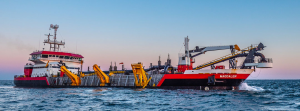
The winter of 2018 saw the trailing suction hopper dredge Magdalen vacuuming sand from a borrow site off the coast of Surf City, N.J., and pumping it ashore to replace a 20-foot-high dune reclaimed by the ocean during Hurricane Sandy’s hungry visit in 2012.

The 356-foot dredge, built by Eastern Shipbuilding in Panama City, Fla., had recently joined R.N. Weeks and B.E. Lindholm in the Weeks Marine hopper dredge fleet (American Ship Review 2019). In the summer of 2020, Magdalen nourished the beaches and dunes at Sea Bright and Long Branch on the Jersey shore.
In mid-August, the vessel was scheduled to travel to Hampton Roads, Va., to join the ongoing project “to deepen and widen the Thimble Shoal Channel leading to Virginia Port Authority-owned public terminals, many private marine terminals, and the world’s largest naval base (at Norfolk),” said Mark Sickles, director of corporate and government relations for Weeks Marine.
Magdalen was designed specifically for U.S. coastal dredging conditions by Netherlands-based Royal IHC. It has a hopper capacity of 8,550 cubic yards, more than the combined volume of its two fleet mates. With a hull form that includes a large bulbous bow, Magdalen also has the edge in speed and fuel efficiency — the money in dredging is in dredging, not steaming between two points. The vessel’s ability to operate close to shore minimizes the length of the shore discharge line and maximizes its self-emptying speed.

The expanded pumping capacity and automation further maximize the dredge’s efficiency. Magdalen has a suction arm on the starboard side, a design that optimizes the capability of the IHC single-wall dredge pump. On the port side is an IHC double-walled booster pump for shore discharge operations. The configuration enables the vessel to pump longer distances via its own dredging and power generation plant.
“From the outset, her performance exceeded expectations,” Sickles said. “In fact, it was her production that led Weeks Marine’s executives to sign a contract to build her sister vessel at Eastern Shipbuilding.” The new vessel will be named R.B. Weeks in honor of Richard B. Weeks, a co-founder of the company and husband of Magdalen Weeks.
Though Magdalen’s inaugural beach nourishment project and last summer’s work were similar, COVID-19 added another layer of corporate and personal responsibility.
“Strict travel restrictions, onboard limitations, heightened sanitation routines, regular temperature checks, personnel surveys prior to returning to the job site and more are part of the new normal on Weeks project sites as well as in the office,” Sickles said.
The delivery of Magdalen in 2017 was a milestone in the company’s century-long history, according to Weeks Marine President Richard S. Weeks.
“With the demand for land reclamation and beach nourishment growing, we believe that better tools are needed to retain our competitive edge,” he said. “She is a very important part of our continued growth as a fully integrated marine construction company.”

